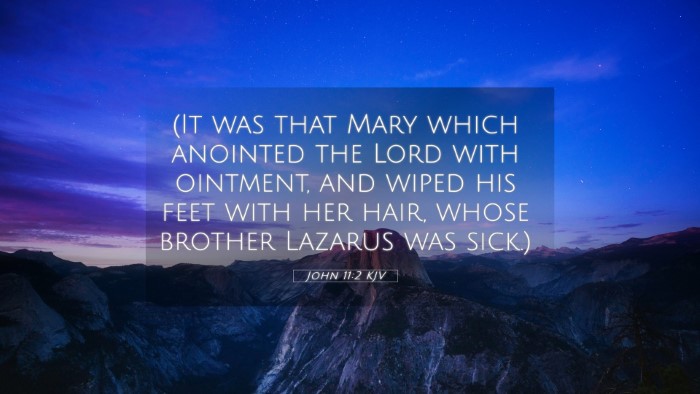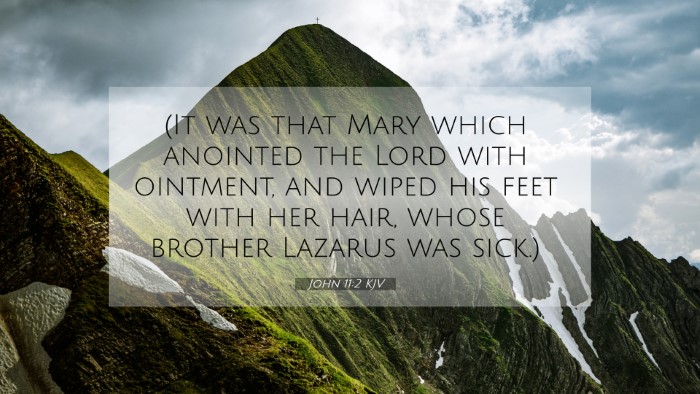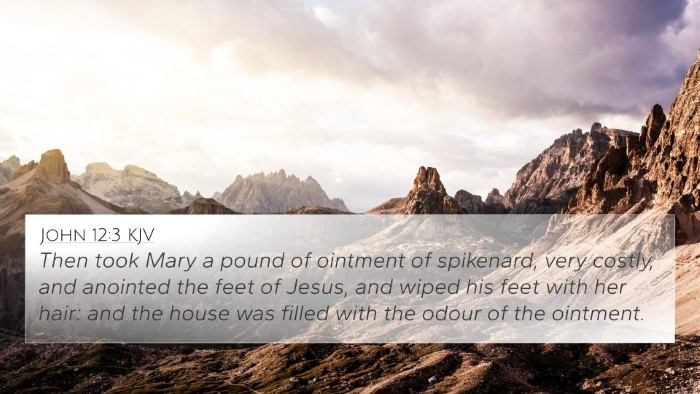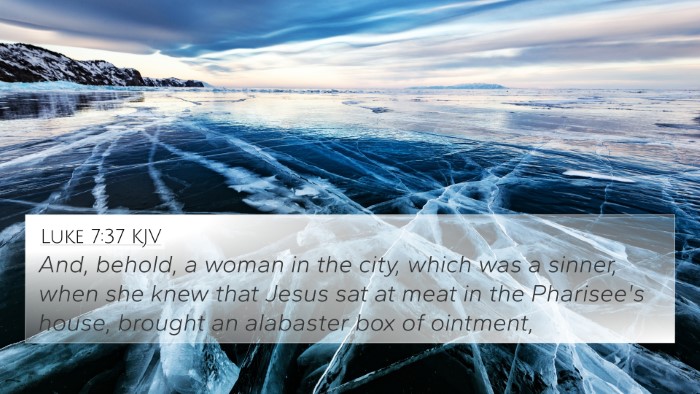Understanding John 11:2
John 11:2 states, "It was that Mary who anointed the Lord with fragrant oil and wiped His feet with her hair, whose brother Lazarus was sick." This verse sets the context for the narrative of Lazarus' resurrection and highlights Mary’s relationship with Jesus and her act of devotion.
Significance of the Verse
This verse not only identifies Mary as the sister of Lazarus but also emphasizes her role in the Acts of Jesus. The reference to her anointing Jesus with oil indicates her understanding of His divine nature and perhaps foreshadows the events of His death and burial.
Insights from Public Domain Commentaries
- Matthew Henry's Commentary: Henry points out that Mary's act of anointing Jesus signifies her deep love and acknowledgment of His worthiness. This demonstrates the profound respect she has for Jesus, contrasting with others who do not recognize His divinity.
- Albert Barnes' Notes: Barnes highlights that the mention of Mary’s past act of anointing Jesus serves to remind readers of her devotion and faith. This historical reference emphasizes the gravity of the situation regarding Lazarus' illness and eventual death.
- Adam Clarke's Commentary: Clarke elaborates on Mary’s importance in the Gospel narrative, particularly her role as a worshipper of Christ. He notes that her act of washing Jesus' feet with her hair signifies humility and total submission to His authority.
Cross-References and Connections
John 11:2 can be linked with several other scripture passages which provide a broader understanding of the themes present in this verse:
- John 12:3: Mary anoints Jesus with costly perfume, directly illustrating her devotion revealed in John 11:2.
- Luke 7:37-38: A woman anoints the feet of Jesus, shedding light on the theme of love and repentance.
- Matthew 26:6-13: The anointing of Jesus sets parallels with Mary’s actions and highlights the significance of honoring Jesus before His crucifixion.
- Mark 14:3: Another narrative of anointing that reinforces the reverence for Jesus among His followers.
- John 11:1: The context of Lazarus’ sickness introduces the family dynamics that are essential in understanding Mary’s relationship with Jesus.
- John 10:41-42: This passage describes the ministry of Jesus in Judea, where Mary’s faith arises amidst the backdrop of Jewish belief.
- Luke 10:38-42: The narrative of Mary and Martha at Jesus’ feet emphasizes the priority of spiritual engagement over worldly concerns.
Thematic Connections
This verse can be explored through various thematic connections as follows:
- Faith and Devotion: Mary’s act speaks of deep faith in Jesus which is pivotal to understanding biblical characters’ responses to Jesus’ ministry.
- Recognition of Christ's Sovereignty: Her acknowledgment of Jesus’ authority foreshadows the eventual resurrection of Lazarus and involves a deeper theological understanding of Christ’s power over life and death.
- Love and Service: The acts of devotion by Mary illustrate a consistent biblical theme of love manifesting through service and humility.
- Intercessory Prayer: Mary’s situation begs an examination of intercessory dynamics present in the family unit and relationships within scripture.
- Foreshadowing: The anointing foreshadows the significance of Jesus’ impending death which becomes a pivotal theme in the Johannine narrative.
Inter-Biblical Dialogue
John 11:2 invites readers into a broader dialogue across scripture:
- Old Testament Connections: The acts of anointing in the Old Testament (e.g., Exodus 30:22-33) establish significance in ritual and preparation for consecration, reflecting themes of holiness that extend to New Testament revelations.
- New Testament Reflection: The interactions of various followers of Christ, including Mary, showcase a continuity of faith responses that reflect back to the teachings of Jesus and His role as the Messiah.
- The Apostolic Teachings: The importance of Christ’s death and resurrection is echoed throughout Paul's epistles, whereby Mary’s actions provide rich illustrations of the foundational faith responses the apostles taught.
Conclusion
In summary, John 11:2 is a profound verse that encapsulates the relationship between Jesus and Mary, marked by devotion and faith. By exploring its connections, the verse underscores significant themes of love, recognition, and the anticipation of Christ’s resurrection power. This intricate intertwining of scripture enhances our understanding of the Bible through thematic connections and biblical cross-referencing.






